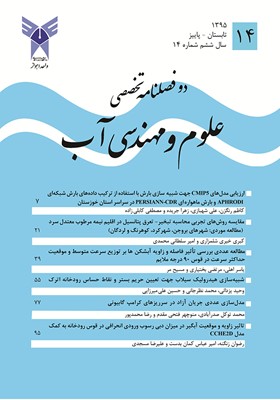Influence of intake’s angel and location on sediment rate in bend of river using CCHE2D software
Subject Areas : Irrigation and Drainageرضوان زنگنه 1 , امیرعباس کمانبدست 2 * , علیرضا مسجدی 3
1 - گروه سازه های آبی، واحد اهواز، دانشگاه آزاد اسلامی، اهواز، ایران.
2 - گروه سازه های آبی، واحد اهواز، دانشگاه آزاد اسلامی، اهواز، ایران.
3 - گروه سازه های آبی، واحد اهواز، دانشگاه آزاد اسلامی، اهواز، ایران.
Keywords: Sediment Transport, مدل ریاضی, CCHE2D, Angle of Intake, River Bend, آبگیر, رسوب گذاری, هیدرولیک جریان و شبیه سازی,
Abstract :
Investigating the features and flow behavior and related component is one of the complex phenomena that make using of software inevitable. The rivers carry sediment content along with water which is created by erosion of riverbed sediment and erosion caused by rainfall or surface runoff flowing over the catchment area. If the action of river dewatering occurs, the entry of sediment into the intake would make new challenges due to the sedimentation. In particular, these factors are valuable for Meander Rivers which have unsteady flow patterns. There are three general approaches to study this process. numerical model was used in this study due to the lower costs compared to existing methods and expediting the process of result obtaining, the model can also be applied to other similar cases to obtain feedbacks resulting from changes in different components that affect the phenomenon under study conditions and evaluate different functions. In this study, simulation of the discharge and sedimentation input into these intakes was investigated to evaluate the hydraulic conditions of flow and sedimentation in the intake with different angles of 30, 45, 60, 75 and 90 by different location (25, 40, 55 and 70) using CCHE2D numerical model that has a sinusoidal-like turn is analyzed. Besides, variation of parameters like velocity, Froude number, shear stress, river bed elevation and total sediment deposits of the river are calculated and discussed. The impact of these different angles on Hydraulic flow was studied. The results of these tests indicated that intake with 90-degree angle and 70 of arc can improve the flow patterns at the inlet. This can overcome sedimentation problems and water shortages in some seasons.
اسماعیل نژاد، م.(1381). بررسی آزمایشگاهی هیدرولیک جریان ورودی به آبگیرهای سد انحرافی حمیدیه با استفاده از میکرومدل، پایان نامه کارشناسی ارشد مهندسی تأسیسات آبیاری، دانشگاه شهید چمران اهواز.
تائبی، ح.، شفاعی بجستان، م. و کاهه، م. (1381). شبیه سازی عددی جریان در قوس 90 درجه با استفاده از مدل CCHE2D، هشتمین سمینار بین المللی مهندسی رودخانه، دانشگاه شهید چمران.
روغنیان، س.(1389). بررسی خصوصیات هیدرولیکی جریان در رودخانه کارون با استفاده از مدل CCHE2D، پایاننامه کارشناسی ارشد- دانشگاه آزاد اسلامی – واحد علوم و تحقیقات خوزستان.
سازمان مدیریت منابع آب ایران. (1384). راهنمای روشهای رسوبگیری در آبگیرها، نشریه شماره 144-ن سازمان مدیریت و برنامه ریزی کشور معاونت امور فنی.
کمان بدست، ا و بهشتی، ع. (1390). تحلیل عددی پارامترهای هیدرولیکی در رودخانه ها، اولین کنفرانس بین المللی و سومین کنفرانس ملی سد و نیروگاه های برق آبی.
کمان بدست، الف، (1389). کتاب راهنمای نرم افزار CCHE2D انتشارات دانشگاه آزاد اسلامی واحد اهواز.
منادی زاده ،م .(1392). بررسی آزمایشگاهی هیدرولیک جریان در آستانه آبگیر کشت و صنعت دهخدا با استفاده از میکرو مدل، پایانامه کارشناسی ارشد - دانشگاه آزاد شوشتر.
نیکنام، ع. (1391). شبیه سازی الگوی رسوب گذاری در مخزن سد دز با استفاده از نرم افزار CCHE2D، سومین کنفرانس مدیریت منابع آب ایران- ساری.
Brian, D., Barkdoll, R. and Joob Odgaard, A. (1999). Sediment Control At Lateral Divertion: Limits and Enhacements To Vane Use. Journal of Hydraulic Engineering, 122, 7, pp: 862-870.
Johnson, P.A., Hey, R.D., Tessier, M. and Rosgen, D. L. (2001). Use Of Vanes For Control Of Scour At Vertical Wall Abutments. Journal Of Hydraulic Engineering, 127, 9, , pp: 772-778.

